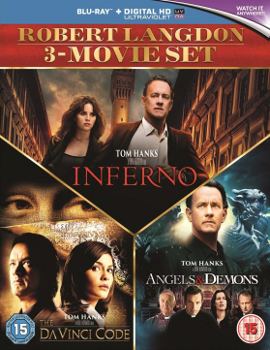Directed by Ron Howard Based on Novels
by Dan Brown | Story by Dan Brown Starring Tom Hanks
(See below) | |
 | ||
Produced by Brian Grazer
Ron Howard
John Calley (1-2) Screenplay by Akiva Goldsman (1-2)
David Koepp (2-3) | ||
The Robert Langdon film series is a series of American mystery thriller films directed by Ron Howard. The films focus on the eponymous professor, a fictional character appearing in a series of novels by author Dan Brown. The first film in the series was The Da Vinci Code (2006), followed by Angels & Demons (2009) and Inferno (2016). The series has grossed almost $1.5 billion worldwide.
Contents
Background
Dan Brown novels about Robert Langdon series: Angels & Demons (2000), The Da Vinci Code (2003), and Inferno (2013), were successful around the world and became bestsellers, and soon adapted into films in with Ron Howard directing and producing, with Tom Hanks portrayed Professor Robert Langdon, which was released by Columbia Pictures.
The Da Vinci Code (2006)
A murder inside the Louvre and clues in Da Vinci paintings lead to the discovery of a religious mystery protected by a secret society for two thousand years, which could shake the foundations of Christianity.
Angels & Demons (2009)
Harvard symbologist Robert Langdon continues to work to solve a murder and prevent a terrorist act against the Vatican.
Inferno (2016)
When Robert Langdon wakes up in an Italian hospital with amnesia, he teams up with Dr. Sienna Brooks, and together they must race across Europe against the clock to foil a deadly global plot.
The Lost Symbol
Following the worldwide successes of The Da Vinci Code in 2006 and Angels & Demons in 2009, which were both based on Brown's novels, starring Tom Hanks as Robert Langdon and produced and directed by Ron Howard, Columbia Pictures began production on a film adaptation of The Lost Symbol. Hanks and Howard were expected to return for the film adaptation of The Lost Symbol, along with the franchise's producers Brian Grazer and John Calley. Sony Pictures eventually hired three screenwriters for the project, beginning with Steven Knight and then hiring Brown himself. In March 2012, Danny Strong was also hired to collaborate on the adaptation.
According to a January 2013 article in Los Angeles Times, the final draft of the screenplay was due sometime in February, with pre-production expected to start in the mid-2013. In July 2013, Sony Pictures announced they would instead adapt Inferno for an October 14, 2016 release date with Howard as director, David Koepp adapting the screenplay and Hanks reprising his role as Robert Langdon.
Angels & Demons
There are many differences between the novel and the film.
